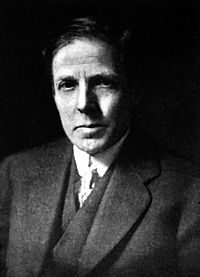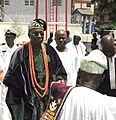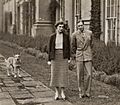Suit (clothing) facts for kids

A suit ('lounge suit' or 'business suit') is a semi-formal ensemble. It always includes a jacket and trousers (pants). In classical gentlemen's tailoring, a waistcoat (U.S: vest) is usually worn with single-breasted suits.
In formal or semi-formal wear, the suit is worn with various other items. Quality socks, leather lace-up shoes, and a tie are essential: if a tie is not worn, that is casual wear. This outfit is worn in many countries by men in professional jobs such as business, law, and politics. It is also sometimes worn by women and in such cases a dress skirt or tailored trousers are worn.
A suit can be part of a dress code, a set of rules that say what people should wear at an event. Ideally, a suit is tailored to the individual wearer. 'Off-the-peg' suits are much cheaper, but they may need adjusting by a tailor.
Parts of a suit
- A coat or jacket ('coat' is the traditional name in tailoring). This is usually made of worsted wool, but silk, cotton, linen or polyester are also possible. Suit jackets have a collar, pockets, and a silk or polyester lining. Suit jackets come in many colours, but the most common are dark blue, brown and grey. Suit jackets come in different styles including double-breasted (buttons on both sides of the front), single-breasted (buttons down one side of the front only), two-button, three-button or more.
- Trousers (U.S: dress pants) should match the coat. It is essential that the jacket and trousers should be made of the same cloth by the same tailors. If not, the outfit is casual. Trousers are worn ironed, with a crease.
- Waistcoat (vest), either in the same cloth, or a fancy design in silk.
Accessories
- The shirt is made of silk, cotton or linen. It may have a stiff collar, and is ironed. Shirts worn with suits need not be white, but should be of conservative style.
- A tie is usually worn. It made be of silk or polyester, and it usually has a colour or pattern on it. Occasionally, a suit is worn with a bow tie or no tie at all.
- Sometimes, if a waistcoat is not worn, a lightweight sleeveless v-neck wool garment may be worn.
- Socks are often made of silk, cotton or a mix of cotton and polyester. Dress socks are usually in a dark colour such as black, dark blue or grey. In some countries, such as Germany, many men wear tights under their suits.
- Shoes are usually made of leather, and usually dark-coloured leather (black or brown) which is waxed and polished.
Social aspects
As a general guide, dress is more formal in northern Europe and the eastern United States, especially New York. More relaxed styles are found in warmer climates such as southern Europe and the western United States. The main differences are the tie, which is rarely worn in warmer climes, and the colours, which tend to be brighter in warmer climes.
The suit has become the standard dress in international politics and business. This applies to almost all countries. The exceptions are countries whose leaders wish to make a "statement". By that is meant, they want to underline their difference by making a non-verbal show of independence. Examples would be people of high status from the Middle East or from some African countries.
Another angle is cost. Suits are expensive, because to fit well they need to be tailored. Ordinary people wear them less today than fifty years ago, and this is one of the main reasons. They are semi-formal clothing, good for wearing to the office, but not so good for watching a football match. A trend towards informal dress started in the 1960s and 1970s, and has changed the way many people dress. All the same, high-status men do still wear suits. They "say" something about the wearer, or so it is thought.
Origin
The evolution of the suit began with changes made to formal English male dress by Beau Brummell in the early 1800s. More changes were made later in the 19th century by tailors in London and elsewhere. By the end of that century photographs show men wearing suits that are almost the same as those worn today.
Images for kids
-
Former US Secretary of State Condoleezza Rice and Turkish President Abdullah Gül wearing Western-style business suits.
-
he Oba is a spiritual leader in Nigerian culture with the respect (status) of royalty. This was a ceremony celebrating the 50th anniversary of the Nigerian Navy.
-
A man dressed in a three-piece suit and bowler hat.
-
Prince George, Duke of Kent in the early 1930s wearing a double-breasted suit with only the bottom buttons fastened
-
Angélica Rivera wearing a modern-day skirt suit
See also
 In Spanish: Traje para niños
In Spanish: Traje para niños














